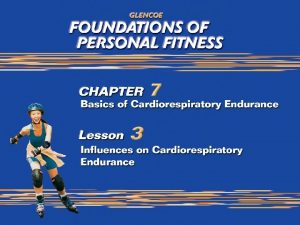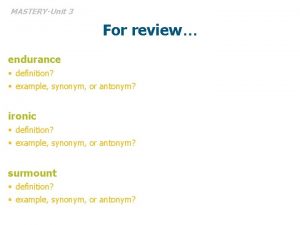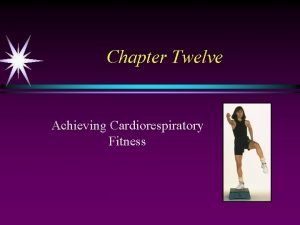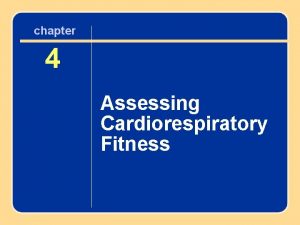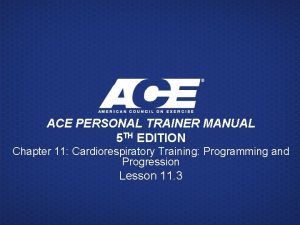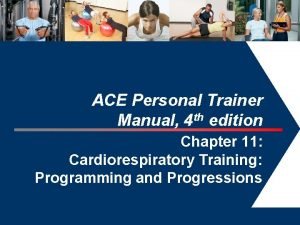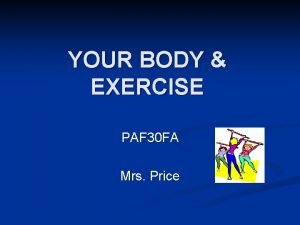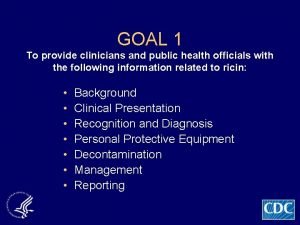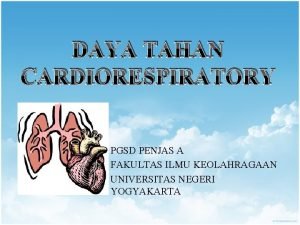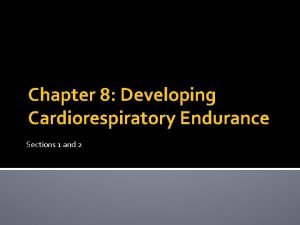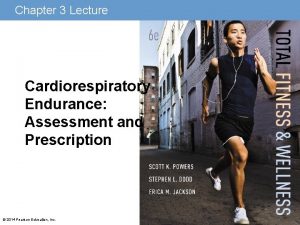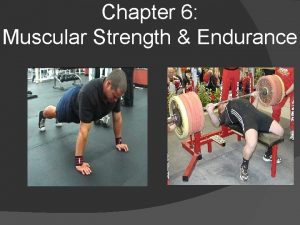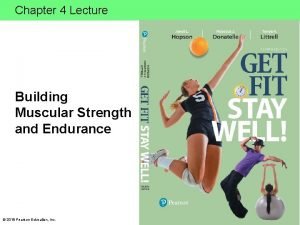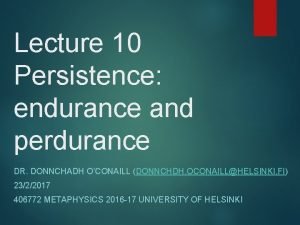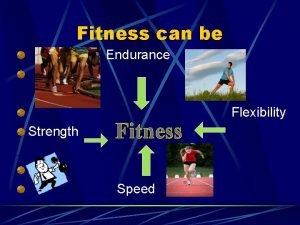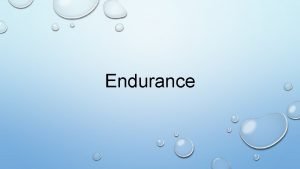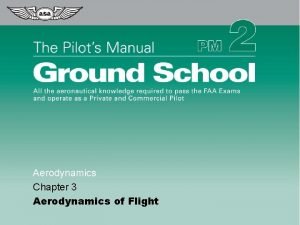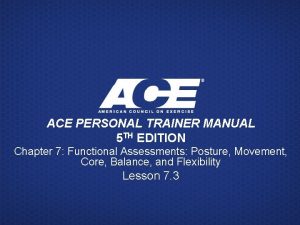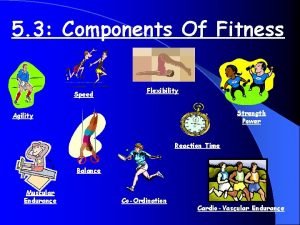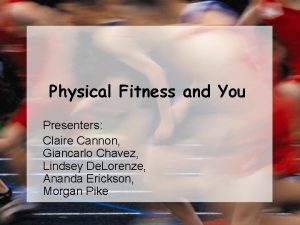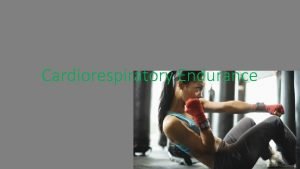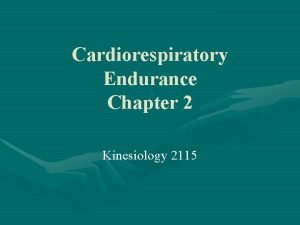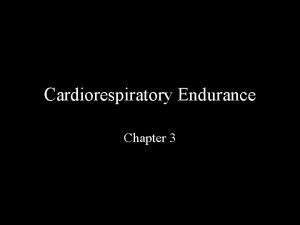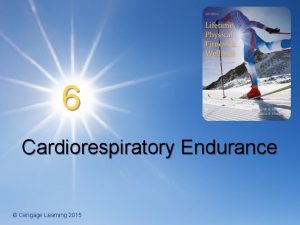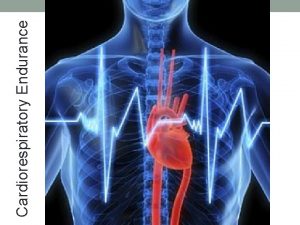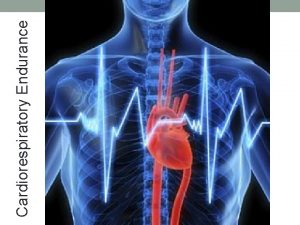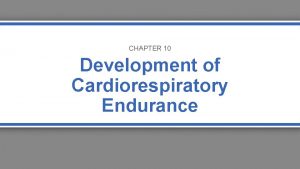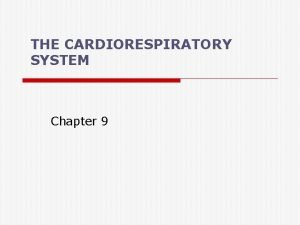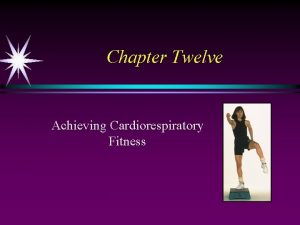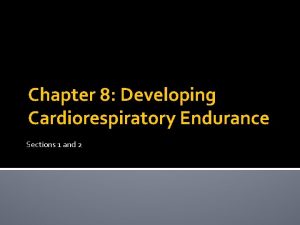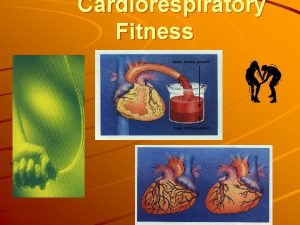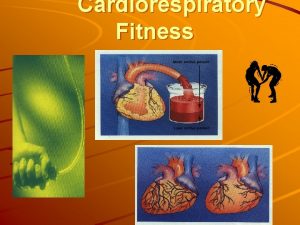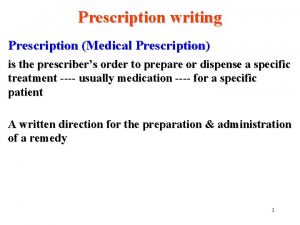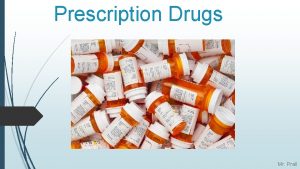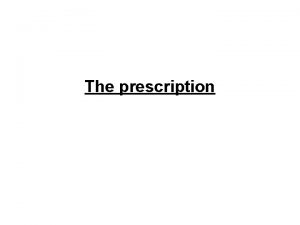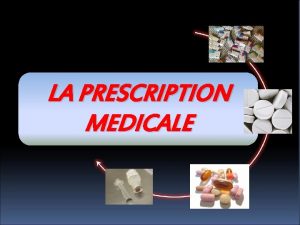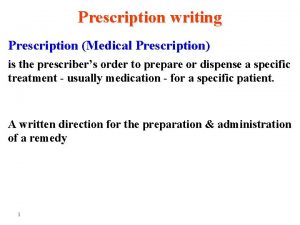Chapter 3 Lecture Cardiorespiratory Endurance Assessment and Prescription


























- Slides: 26

Chapter 3 Lecture Cardiorespiratory Endurance: Assessment and Prescription © 2014 Pearson Education, Inc.

Learning Objectives • Explain the benefits of developing cardiorespiratory endurance • Identify the two energy systems used in ATP production for muscular contraction • Discuss the role of the circulatory and respiratory systems during exercise • Define VO 2 max • Identify the main changes that occur in the skeletal, circulatory, and respiratory systems in aerobic training • List several modes of cardiorespiratory training • Outline the main components of an exercise prescription for cardiorespiratory fitness • Design a cardiorespiratory endurance exercise program © 2014 Pearson Education, Inc.

What Is Cardiorespiratory Endurance and What Does It Do? • The ability to perform aerobic exercises for a prolonged period of time • Promotes weight loss • Reduces risk of cardiovascular disease (CVD) • Widely considered to be the most important component of health-related physical fitness © 2014 Pearson Education, Inc.

What Is the Cardiorespiratory System? • It is made up of the following two cooperating systems: – the cardiovascular/circulatory (the heart and blood vessels) system – the respiratory (the lungs and related muscles) system • Together, these systems deliver oxygen and nutrients, and remove waste products, throughout the body • Exercise challenges the cardiorespiratory system by increasing the demand for oxygen and nutrients in working muscles © 2014 Pearson Education, Inc.

The Role of VO 2 max • The most valid measure of cardiorespiratory fitness • VO 2 max = maximal aerobic capacity (the maximum amount of oxygen the body can take in and use during exercise) • VO 2 max measures the endurance of the cardiorespiratory system and the skeletal muscles during exercise © 2014 Pearson Education, Inc.

The Cardiovascular System The Heart (two pumps in one) • Right side/pulmonary circuit • Left side/systemic circuit Blood Vessels • Arteries: carry blood away from the heart • Veins: carry blood from body tissues back to the heart • Capillaries: thin-walled blood vessels that allow oxygen and nutrients to pass through to tissues, and waste products (e. g. , carbon dioxide) to pass back into the vascular system for processing © 2014 Pearson Education, Inc.

The Respiratory System • Controls breathing • Consists of lungs and related muscles • The lungs – exhale carbon dioxide and waste products – inhale oxygen, some of which passes into alveoli (tiny air sacs), and then into capillaries – send oxygen-rich blood back to the heart © 2014 Pearson Education, Inc.

Blood Flow Through the Cardiorespiratory System PLAY Exercise Video: The radial pulse PLAY Exercise Video: The carotid pulse © 2014 Pearson Education, Inc.

Getting Energy for Exercise • Energy – The fuel needed for muscle motion – Derived from the breakdown of food • Energy released from the breakdown of food creates a compound called ATP (adenosine triphosphate) • ATP is stored in muscle and cells in small amounts • The breakdown of ATP creates energy in a form that muscles can use for movement • Therefore, ATP must be available for muscles in order for them to function © 2014 Pearson Education, Inc.

Aerobic and Anaerobic Systems Two systems in muscle cells produce ATP • Anaerobic (without oxygen) – Provides energy for exercise that is short duration and intense, at the beginning of activity – Produced through glycolysis, a process that breaks down carbohydrates – Can only use carbohydrates as an energy source • Aerobic (with oxygen) – – The primary system for cardiorespiratory endurance Relies on oxygen for ATP production Can use fats, proteins, and carbohydrates to produce ATP Supports prolonged exercise, with a shift from carbohydrates to fats as the primary energy source – Most daily activities rely on aerobic ATP production © 2014 Pearson Education, Inc.

Changes in the Cardiorespiratory System from Exercise and Training Responses to exercise • Short-term changes that occur during and immediately after exercise Adaptations to exercise • Changes over time that accrue with regular exercise © 2014 Pearson Education, Inc.

Health Benefits of Cardiorespiratory Endurance • • Lower risk of heart disease Reduced risk of type 2 diabetes Lower blood pressure Increased bone density Increased energy Improved well-being and self-esteem Easier weight control Better sleep © 2014 Pearson Education, Inc.

Evaluating Cardiorespiratory Endurance 1. 5 -mile run test • One of the simplest and most accurate tests 1 -mile walk test • Widely used field measure Cycle ergometer test • Non-weight-bearing/good for people with joint problems Step test • Can be performed by people at any fitness level © 2014 Pearson Education, Inc.

Designing Your Aerobic Exercise Program • Set goals (short-term and long-term) • Warm-up • Workout (FITT principle) – Frequency (e. g. , 3– 5 times per week) – Intensity (e. g. , 50– 85% of maximal heart rate) – – training threshold target heart rate (THR) heart rate reserve (HRR) Borg Rating of Perceived Exertion (RPE) – Time/duration (e. g. , 20– 60 minutes per session) – Type/mode of exercise (e. g. , jogging) • Cool-down • Main stages of the exercise program: initial conditioning, progression, and maintenance © 2014 Pearson Education, Inc.

Calculate Target Heart Rate (THR) • Maximal HR – HRmax = 206. 9 – (. 67 x age yrs. ) • 206. 9 – (. 67 x 20 yrs. ) = HRmax of 194 bpm – HRR (heart rate reserve) = HRmax – Resting HR • 194 HRmax – 60 RHR = HRR of 134 bpm – Calculate 50% to 85% of HRR and add RHR to obtain THR • . 50 x 134 HRR = 67 bpm + 60 RHR = THR of 127 bpm • . 85 x 134 HRR = 114 bpm + 60 RHR = THR of 174 bpm – THR range of 127 bpm to 174 bpm for 20 yr. old © 2014 Pearson Education, Inc.

Sample Workout in the Target Heart Rate Range © 2014 Pearson Education, Inc.

Exercises and Activities That Can Improve Cardiorespiratory Fitness © 2014 Pearson Education, Inc.

Developing an Individualized Exercise Prescription Initial Conditioning Phase • Lasts roughly 2– 4 weeks • Start at a comfortable intensity level • Increase duration or intensity gradually (separately not both at once) • Be aware of body pains, and rest as needed © 2014 Pearson Education, Inc.

Developing an Individualized Exercise Prescription (cont. ) Improvement Phase • Ranges from 12 to 40 weeks • Progress is more rapid than in initial phase • Increase duration and frequency first, then intensity © 2014 Pearson Education, Inc.

Developing an Individualized Exercise Prescription (cont. ) Maintenance Phase • Fitness goal has been achieved • Continue exercising regularly, but no need to continue increasing duration, frequency, and intensity • Key factor in maintenance appears to be intensity level © 2014 Pearson Education, Inc.

Training Techniques Endurance training techniques = continuous activity at a constant intensity level Cross Training • Alternate multiple training modes • May reduce risk of overuse injuries • Improves overall cardiorespiratory endurance • Some people enjoy increased variety © 2014 Pearson Education, Inc.

Training Techniques (cont. ) Interval Training • Often used by athletes to attain higher endurance levels in specific fitness areas • Uses repeated sessions (intervals) of higherintensity exercises alternated with lowerintensity exercises • May be used to spur gains in intensity during improvement phase • Should not be done on a daily basis © 2014 Pearson Education, Inc.

Staying Motivated • Most common reason cited for dropping out of exercise programs is lack of time • Recognize that making time for exercise can be challenging, but not impossible • Schedule a regular time to exercise and stick with it • Remember that small time investments in exercise can lead to big improvements: in your total available hours per week, as few as three 30 -minute workouts (workout phase) can improve cardiorespiratory health • Create goals and seek support • Keep a record of your progress • Don't get discouraged by initial aches or pains; they will improve as you continue to exercise • You will feel, look, and function better in all areas of your life © 2014 Pearson Education, Inc.

Summary • Cardiorespiratory fitness benefits include lower disease risk, greater capacity for everyday tasks, and improved self-esteem • ATP provides the energy muscles need to move: It is produced by the anaerobic (without oxygen) and aerobic (with oxygen) systems • Anaerobic ATP is the primary energy source for shortterm exercise; aerobic ATP production fuels prolonged exercise • The cardiorespiratory system is two cooperating systems: 1) the cardiovascular/circulatory and 2) the respiratory. The circulatory system transports blood carrying oxygen and nutrients to body tissues. The respiratory system loads oxygen into and removes carbon dioxide from the blood. © 2014 Pearson Education, Inc.

Summary (cont. ) • Responses are short-term bodily changes that meet the immediate demands of exercising; adaptations are long-term changes that result from regular training, and remain as long as training continues. • VO 2 max measures the maximum capacity of the cardiorespiratory system to transport and use oxygen during exercise. Different field tests can estimate VO 2 max. • The main elements of an exercise prescription are warm-up, workout, and cool-down © 2014 Pearson Education, Inc.

Summary (cont. ) • The components of the workout phase are frequency, intensity, time/duration, and type/mode of exercise (FITT) • An exercise prescription for improving cardiorespiratory fitness has three phases: initial conditioning, improvement, and maintenance • Maintaining a successful exercise program requires managing your time and selecting activities you enjoy © 2014 Pearson Education, Inc.
 Describe cardiorespiratory endurance
Describe cardiorespiratory endurance Endurance synonym
Endurance synonym Chapter 12 achieving cardiorespiratory fitness
Chapter 12 achieving cardiorespiratory fitness 01:640:244 lecture notes - lecture 15: plat, idah, farad
01:640:244 lecture notes - lecture 15: plat, idah, farad Tissues in the circulatory system
Tissues in the circulatory system Assessing cardiorespiratory fitness
Assessing cardiorespiratory fitness Ace ift model cardiorespiratory
Ace ift model cardiorespiratory Ace ift model cardiorespiratory
Ace ift model cardiorespiratory Paf30
Paf30 Cardiorespiratory failure
Cardiorespiratory failure Cardiorespiratory adalah
Cardiorespiratory adalah Developing cardiorespiratory fitness
Developing cardiorespiratory fitness Benefits of cardiorespiratory training
Benefits of cardiorespiratory training Difference between strength and endurance
Difference between strength and endurance Principles of weight training
Principles of weight training Venn diagram of muscular strength and endurance
Venn diagram of muscular strength and endurance Perdurance vs endurance
Perdurance vs endurance Be endurance
Be endurance Difference between strength and endurance
Difference between strength and endurance Tinman endurance coaching
Tinman endurance coaching Let us run with endurance
Let us run with endurance What is endurance
What is endurance Electrical endurance class e2
Electrical endurance class e2 Aviation
Aviation Rombergs test
Rombergs test Balance example in sport
Balance example in sport Muscular endurance workout
Muscular endurance workout
